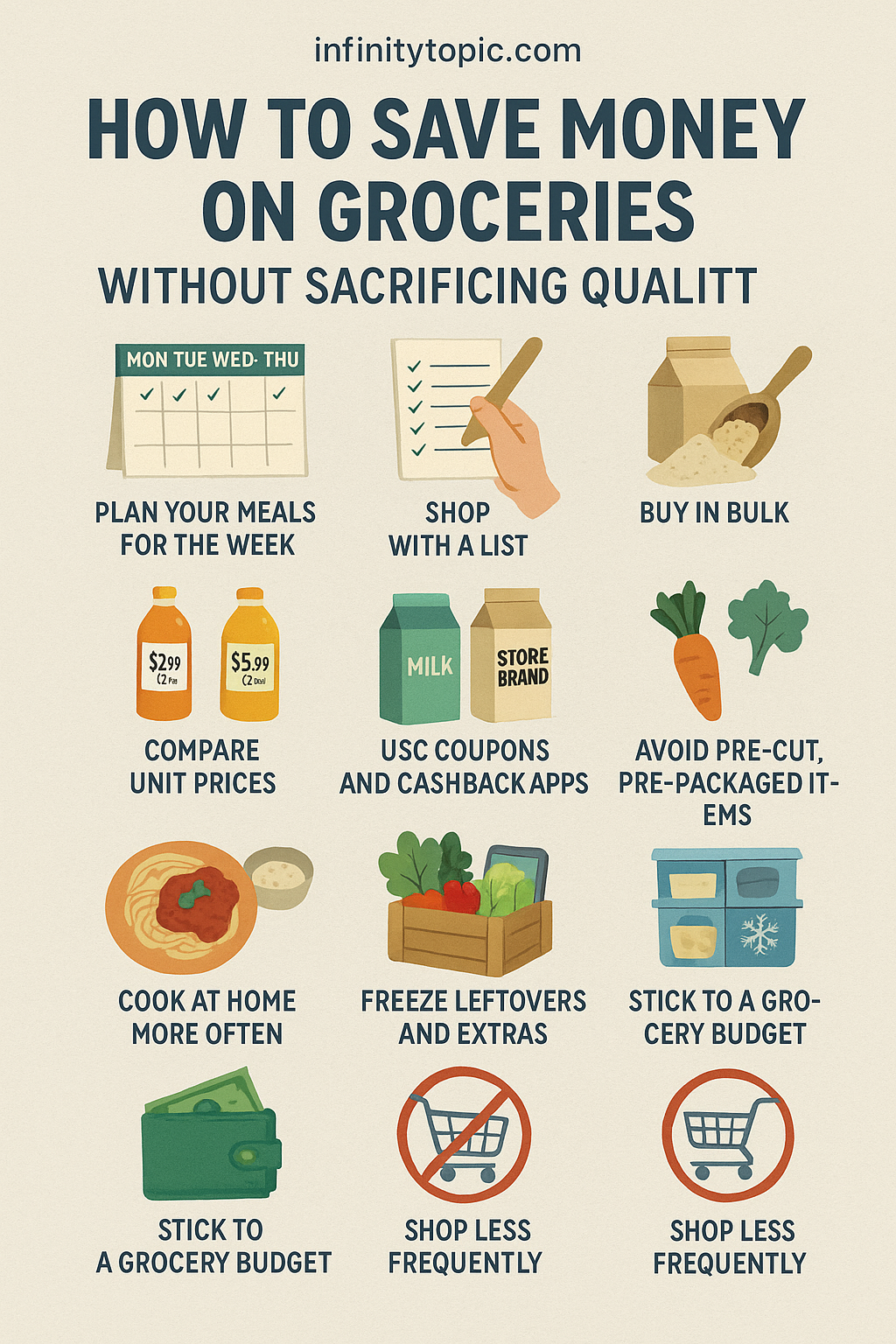Groceries are one of the biggest regular expenses for most households—but they’re also one of the easiest to reduce. With a few smart habits and simple strategies, you can save money on food while still eating well and enjoying your meals.
This article will teach you how to cut down your grocery bill, avoid food waste, and make better choices at the store—without switching to instant noodles.
1. Plan Your Meals for the Week
Meal planning helps you:
- Buy only what you need
- Avoid last-minute takeout
- Waste less food
Pick 5–7 meals for the week based on what’s in your fridge and what’s on sale. Create a shopping list from the ingredients and stick to it.
Pro tip:
Use apps like Mealime, Plan to Eat, or a simple calendar to plan faster.
2. Shop With a List (and Don’t Shop Hungry)
Going to the grocery store without a list is like shopping blind. You’ll likely:
- Forget key items
- Buy duplicates
- Overspend on impulse
Make a list and eat something before you shop. Hunger makes everything look delicious—and expensive.
3. Buy in Bulk (But Only What You Use)
Bulk buying can save money, especially for:
- Rice, pasta, and beans
- Oats and flour
- Frozen vegetables
- Toilet paper and cleaning supplies
But avoid buying perishable items in bulk if you can’t use them before they expire.
4. Compare Unit Prices
Don’t be fooled by packaging. Always check the unit price (price per pound, ounce, or liter). Sometimes the bigger item isn’t the better deal.
Stores often display unit prices on shelf labels. Use them to get the most value for your money.
5. Choose Store Brands
Generic or store-brand products are often made by the same companies that produce name brands—just without the fancy packaging.
Try store-brand versions of:
- Canned goods
- Dairy products
- Spices and condiments
- Baking ingredients
You’ll save 20–40% without noticing a difference.
6. Use Coupons and Cashback Apps
Take advantage of tools like:
- Ibotta
- Fetch Rewards
- Rakuten
- Store loyalty cards
These apps give you cashback or discounts just for scanning your receipts or linking your store account.
7. Cook at Home More Often
Eating out or ordering food is usually 3 to 5 times more expensive than cooking at home. Even simple meals like pasta, stir fry, or rice bowls are healthier and cheaper when homemade.
Batch cook meals and use leftovers for lunch or dinner the next day.
8. Avoid Pre-Cut, Pre-Packaged Items
Items like:
- Pre-cut fruits and veggies
- Bagged salads
- Pre-marinated meats
may save time, but they’re significantly more expensive. Buy whole ingredients and prep them yourself to save money and reduce packaging waste.
9. Buy Seasonal and Local Produce
Fruits and vegetables that are in season are:
- Cheaper
- Fresher
- Tastier
Visit local farmers’ markets or use seasonal produce calendars to guide your shopping.
10. Freeze Leftovers and Extras
Got extra ingredients or cooked too much? Freeze it! This prevents waste and gives you ready-made meals on busy days.
Freeze:
- Leftover soup or chili
- Overripe bananas for smoothies
- Extra bread, cooked rice, or chopped veggies
11. Stick to a Grocery Budget
Set a realistic weekly or monthly budget for groceries. Track your spending using:
- A notes app
- A budgeting app (like YNAB or Mint)
- A physical envelope system
Sticking to a budget makes you more mindful and helps avoid overspending.
12. Shop Less Frequently
Every time you go to the store, you’re tempted to buy more. Try shopping:
- Once a week (with a full list)
- Once every two weeks for staples
Fewer trips = fewer temptations.
Final Thoughts: Small Changes, Big Savings
Saving money on groceries doesn’t mean eating less or worse. It’s about being strategic and intentional with your food choices and purchases.
Start by picking 2–3 tips from this list to try this week. With time, they’ll become habits—and your grocery bill will shrink without you even noticing.
